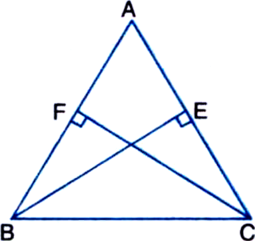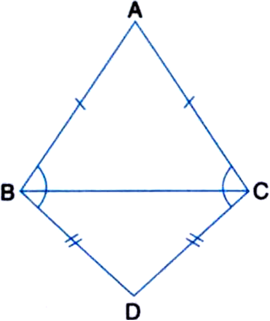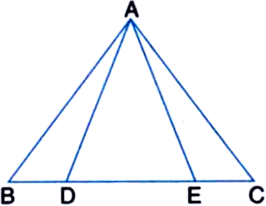 Short Answer Type
Short Answer Type
(i) ∆ABE ≅ ∆ACF
(ii) AB = AC, i.e., ∆ABC is an isosceles triangle.

 Long Answer Type
Long Answer Type∆ABC is an isosceles triangle in which AB = AC. Side BA is produced to D such that AD = AB (see figure). Show that ∆BCD is a right angle.
 Short Answer Type
Short Answer Type∵ AB = AC
∴ ∠ACB = ∠ABC
| Angles opposite to equal sides of ∆ABC
⇒ 2∠2 = 2∠1
| ∵ CE and BD are the bisectors of ∠C and ∠B respectively
⇒ ∠2 = ∠1
⇒ BP = PC ...(1)
| Sides opposite to equal angles of ∆PBC
In ∆BPE and ∆CPD,
BP = CP | Proved above
∠EBP = ∠DCP | Proved above
∠BPE = ∠CPD
| Vertically Opposite Angles
∴ ∆BPE ≅ ∆CPD | ASA Axiom
PE = PD | C.P.C.T.
⇒ PD = PE ...(2)
Adding (1) and (2), we get
BP + PD = PC + PE
⇒ BD = CE.
 Long Answer Type
Long Answer TypeABC is a triangle in which ∠B = 2∠C. D is a point on side BC such that AD bisects ∠BAC and AB = CD. Prove that ∠BAC = 72°.
[Hint. Take a point P on AC such that BP bisects ∠B. Join P and D.]
 Short Answer Type
Short Answer Type
